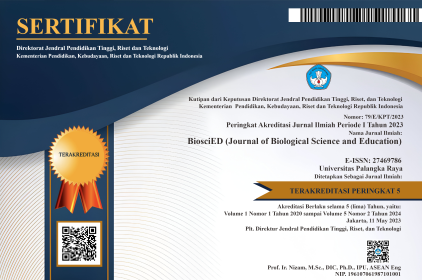Biopython: Comparing the DNA Polymerase I (polA) Gene of Thermophilic, Mesophilic, and Psychrophilic Bacteria
DOI:
https://doi.org/10.37304/bed.v2i1.2714Keywords:
Biopython, Python, Bioinformatics, Computational BiologyAbstract
Biopython is a specialized Python tool for computational molecular biology. Various computational molecular analysis that can be performed using Biopython, such as reconstructing phylogenetic trees, multiple sequence analysis, generating complementary sequences, counting amino acids, etc. This technical notes paper describes in detail the procedures computational DNA sequence analysis using Biopython. The DNA polymerase I (polA) gene sequences of bacteria were used in this study to compare the differences between Thermophilic, Mesophilic, and Psychrophilic bacteria.
Downloads
References
Bayat, A. (2002). Science, medicine, and the future: Bioinformatics. BMJ (Clinical Research Ed.), 324(7344), 1018–1022. PubMed. https://doi.org/10.1136/bmj.324.7344.1018
Brown, W. E., Stump, K. H., & Kelley, W. S. (1982). Escherichia coli DNA polymerase I. Sequence characterization and secondary structure prediction. The Journal of Biological Chemistry, 257(4), 1965–1972.
Caetano-Anollés, D. (2013). Polymerase Chain Reaction. In S. Maloy & K. Hughes (Eds.), Brenner’s Encyclopedia of Genetics (Second Edition) (pp. 392–395). Academic Press. https://doi.org/10.1016/B978-0-12-374984-0.01186-4
Cavicchioli, R. (2016). On the concept of a psychrophile. The ISME Journal, 10(4), 793–795. PubMed. https://doi.org/10.1038/ismej.2015.160
Chang, J., Chapman, B., Friedberg, I., Hamelryck, T., de Hoon, M., Cock, P., Antao, T., Talevich, E., & Wilczynski, B. (2020). Biopython Tutorial and Cookbook. https://biopython.org/
Chapman, B., & Chang, J. (2000). Biopython: Python Tools for Computational Biology. SIGBIO Newsl., 20(2), 15–19. https://doi.org/10.1145/360262.360268
Chen, C.-H., & Berns, D. S. (1980). Thermotropic Properties of Thermophilic, Mesophilic, and Psychrophilic Blue-green Algae. Plant Physiology, 66(4), 596–599. https://doi.org/10.1104/pp.66.4.596
Chien, A., Edgar, D. B., & Trela, J. M. (1976). Deoxyribonucleic acid polymerase from the extreme thermophile Thermus aquaticus. Journal of Bacteriology, 127(3), 1550–1557. PubMed. https://doi.org/10.1128/JB.127.3.1550-1557.1976
Cock, P. J. A., Antao, T., Chang, J. T., Chapman, B. A., Cox, C. J., Dalke, A., Friedberg, I., Hamelryck, T., Kauff, F., Wilczynski, B., & de Hoon, M. J. L. (2009). Biopython: Freely available Python tools for computational molecular biology and bioinformatics. Bioinformatics, 25(11), 1422–1423. https://doi.org/10.1093/bioinformatics/btp163
Erlich, H. A. (1989). Polymerase chain reaction. Journal of Clinical Immunology, 9(6), 437–447. https://doi.org/10.1007/BF00918012
Fourment, M., & Gillings, M. R. (2008). A comparison of common programming languages used in bioinformatics. BMC Bioinformatics, 9(1), 82. https://doi.org/10.1186/1471-2105-9-82
Gao, F., & Zhang, C.-T. (2006). GC-Profile: A web-based tool for visualizing and analyzing the variation of GC content in genomic sequences. Nucleic Acids Research, 34(suppl_2), W686–W691. https://doi.org/10.1093/nar/gkl040
Garcia-Diaz, M., & Bebenek, K. (2007). Multiple functions of DNA polymerases. Critical Reviews in Plant Sciences, 26(2), 105–122. PubMed. https://doi.org/10.1080/07352680701252817
Irwin, J. A. (2020). Chapter 6—Overview of extremophiles and their food and medical applications. In R. Salwan & V. Sharma (Eds.), Physiological and Biotechnological Aspects of Extremophiles (pp. 65–87). Academic Press. https://doi.org/10.1016/B978-0-12-818322-9.00006-X
Ishino, S., & Ishino, Y. (2014). DNA polymerases as useful reagents for biotechnology—The history of developmental research in the field. Frontiers in Microbiology, 5, 465–465. PubMed. https://doi.org/10.3389/fmicb.2014.00465
Kagawa, Y., Nojima, H., Nukiwa, N., Ishizuka, M., Nakajima, T., Yasuhara, T., Tanaka, T., & Oshima, T. (1984). High guanine plus cytosine content in the third letter of codons of an extreme thermophile. DNA sequence of the isopropylmalate dehydrogenase of Thermus thermophilus. The Journal of Biological Chemistry, 259(5), 2956–2960.
Kotzekidou, P. (1999). BACILLUS | Bacillus Stearothermophilus. In R. K. Robinson (Ed.), Encyclopedia of Food Microbiology (pp. 124–129). Elsevier. https://doi.org/10.1006/rwfm.1999.0110
LaPelusa, A., & Kaushik, R. (2021). Physiology, Proteins. In StatPearls. StatPearls Publishing. http://www.ncbi.nlm.nih.gov/books/NBK555990/
Lehman, I., & Uyemura, D. (1976). DNA polymerase I: essential replication enzyme. Science, 193(4257), 963. https://doi.org/10.1126/science.781842
Loeb, L. A., & Monnat, R. J. (2008). DNA polymerases and human disease. Nature Reviews Genetics, 9(8), 594–604. https://doi.org/10.1038/nrg2345
Lopez, M. J., & Mohiuddin, S. S. (2021). Biochemistry, Essential Amino Acids. In StatPearls. StatPearls Publishing. http://www.ncbi.nlm.nih.gov/books/NBK557845/
Luscombe, N. M., Greenbaum, D., & Gerstein, M. (2001). What is bioinformatics? A proposed definition and overview of the field. Methods of Information in Medicine, 40(4), 346–358.
Markowetz, F. (2017). All biology is computational biology. PLOS Biology, 15(3), e2002050. https://doi.org/10.1371/journal.pbio.2002050
Musto, H., Naya, H., Zavala, A., Romero, H., Alvarez-Valín, F., & Bernardi, G. (2004). Correlations between genomic GC levels and optimal growth temperatures in prokaryotes. FEBS Letters, 573(1–3), 73–77. https://doi.org/10.1016/j.febslet.2004.07.056
Oshima, T., & Imahori, K. (1971). Isolation of an Extreme Thermophile and Thermostability of Its Transfer Ribonucleic Acid and Ribosomes. The Journal of General and Applied Microbiology, 17(6), 513–517. https://doi.org/10.2323/jgam.17.513
Oshima, T., & Imahori, K. (1974). Description of Thermus thermophilus (Yoshida and Oshima) comb. Nov., a Nonsporulating Thermophilic Bacterium from a Japanese Thermal Spa. International Journal of Systematic and Evolutionary Microbiology, 24(1), 102–112. https://doi.org/10.1099/00207713-24-1-102
Pánek, T., Žihala, D., Sokol, M., Derelle, R., Klimeš, V., Hradilová, M., Zadrobílková, E., Susko, E., Roger, A. J., ?epi?ka, I., & Eliáš, M. (2017). Nuclear genetic codes with a different meaning of the UAG and the UAA codon. BMC Biology, 15(1), 8. https://doi.org/10.1186/s12915-017-0353-y
Piovesan, A., Pelleri, M. C., Antonaros, F., Strippoli, P., Caracausi, M., & Vitale, L. (2019). On the length, weight and GC content of the human genome. BMC Research Notes, 12(1), 106. https://doi.org/10.1186/s13104-019-4137-z
Rother, M., & Krzycki, J. A. (2010). Selenocysteine, Pyrrolysine, and the Unique Energy Metabolism of Methanogenic Archaea. Archaea, 2010, 453642. https://doi.org/10.1155/2010/453642
Saunders, N. F. W., Thomas, T., Curmi, P. M. G., Mattick, J. S., Kuczek, E., Slade, R., Davis, J., Franzmann, P. D., Boone, D., Rusterholtz, K., Feldman, R., Gates, C., Bench, S., Sowers, K., Kadner, K., Aerts, A., Dehal, P., Detter, C., Glavina, T., … Cavicchioli, R. (2003). Mechanisms of thermal adaptation revealed from the genomes of the Antarctic Archaea Methanogenium frigidum and Methanococcoides burtonii. Genome Research, 13(7), 1580–1588. https://doi.org/10.1101/gr.1180903
Schiraldi, C., & De Rosa, M. (2016). Mesophilic Organisms. In E. Drioli & L. Giorno (Eds.), Encyclopedia of Membranes (pp. 1–2). Springer. https://doi.org/10.1007/978-3-642-40872-4_1610-2
Shing, Y. W., Akagi, J. M., & Himes, R. H. (1975). Psychrophilic, mesophilic, and thermophilic triosephosphate isomerases from three clostridial species. Journal of Bacteriology, 122(1), 177–184.
Smith, M. (2020). MRNA Transcription, Translation, and Defects in Developmental Cognitive and Behavioral Disorders. Frontiers in Molecular Biosciences, 7. https://doi.org/10.3389/fmolb.2020.577710
Taylor, W. R. (2006). Transcription and translation in an RNA world. Philosophical Transactions of the Royal Society of London. Series B, Biological Sciences, 361(1474), 1751–1760. PubMed. https://doi.org/10.1098/rstb.2006.1910
Tessari, P., Lante, A., & Mosca, G. (2016). Essential amino acids: Master regulators of nutrition and environmental footprint? Scientific Reports, 6(1), 26074. https://doi.org/10.1038/srep26074
Wages, J. M. (2005). POLYMERASE CHAIN REACTION. In P. Worsfold, A. Townshend, & C. Poole (Eds.), Encyclopedia of Analytical Science (Second Edition) (pp. 243–250). Elsevier. https://doi.org/10.1016/B0-12-369397-7/00475-1
Wu, G. (2009). Amino acids: Metabolism, functions, and nutrition. Amino Acids, 37(1), 1–17. https://doi.org/10.1007/s00726-009-0269-0
Yoon, J.-H., Roy Choudhury, J., Park, J., Prakash, S., & Prakash, L. (2014). A role for DNA polymerase ? in promoting replication through oxidative DNA lesion, thymine glycol, in human cells. The Journal of Biological Chemistry, 289(19), 13177–13185. https://doi.org/10.1074/jbc.M114.556977
Yuan, J., O’Donoghue, P., Ambrogelly, A., Gundllapalli, S., Sherrer, R. L., Palioura, S., Simonovi?, M., & Söll, D. (2010). Distinct genetic code expansion strategies for selenocysteine and pyrrolysine are reflected in different aminoacyl-tRNA formation systems. FEBS Letters, 584(2), 342–349. PubMed. https://doi.org/10.1016/j.febslet.2009.11.005
Zhang, Y., Baranov, P. V., Atkins, J. F., & Gladyshev, V. N. (2005). Pyrrolysine and selenocysteine use dissimilar decoding strategies. The Journal of Biological Chemistry, 280(21), 20740–20751. https://doi.org/10.1074/jbc.M501458200
Downloads
Published
How to Cite
Issue
Section
License
Copyright (c) 2021 Chaidir Adam

This work is licensed under a Creative Commons Attribution 4.0 International License.















